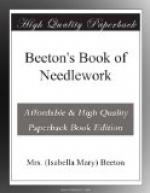2_nd Row_.—Each stitch on the needle is now composed of 3 threads of wool: knit the first plain, the second purl, the third plain; cast off the second over the third, and the first over the second; this leaves but one stitch; repeat from first row until a sufficient length is obtained. This pattern makes very pretty borders.
* * * * *
300.—Knitted Moss Borders.
Materials: Steel needles; moss wool of several shades of green.
Cast on enough stitches for double the width required, say twenty, and knit very tightly in plain knitting, row by row, until a sufficient length has been obtained. Cut off and place the strip on a sieve over a basin of boiling water, and cover it over. When it has absorbed the steam, and while wet, iron it with a box-iron. Then cut the strip down the centre, and unravel the wool on each side. The threads of wool all curling, resemble moss. They are held firmly by the selvedge of the knitting.
* * * * *
301.—German Brioche Stitch
Materials: Wood or ivory needles; wool.
Cast on an even number of stitches.
All the rows are knitted as follows:—Slip 1, taken as for purling, make 1, take 2 together. In the following rows the made stitch must always be slipped, the decreased stitch and the slipped stitch of the previous row knitted together.
[Illustration: 301.—German Brioche Stitch.]
Ordinary Brioche Stitch is made by casting on an even number of stitches, and working the rows as follows:—
Make 1, slip 1, take 2 together; repeat. Note.—The made stitch and the slipped stitch of the previous row must always be knitted together, and the decreased stitch of that row slipped.
* * * * *
NETTING.
302.—NETTING is one of the prettiest and one of the easiest accomplishments of a lady. The materials are simple, while the effects produced by good netting are most elegant and of great durability. One great advantage of netting is that each stitch is finished and independent of the next, so that if an accident happens to one stitch it does not, as in crochet or knitting, spoil the whole work.
Netting, so easy to do, is most difficult to describe. The materials required are—a netting-needle and mesh (see illustration No. 302). These are made of bone, of wood, of ivory, and most commonly of steel. The wood, bone, and ivory are only used for netting wool, the steel for silk, cotton, &c.
The needle is filled by passing the end of the thread through the little hole at the left-hand point, and tying it; then the thread is wound on the needle as on a tatting shuttle. The needles are numbered from 12 to 24; these last are extremely fine. The meshes correspond to the sizes of the needles, and are made of the same materials. The larger the size of the stitch required the thicker the mesh must be selected; indeed, large hat meshes are often used for some patterns. A stirrup to slip over the foot to which the foundation is attached is required by those who do not use a netting cushion, placed before them on the table and heavily weighted; to this the foundation is fastened.




